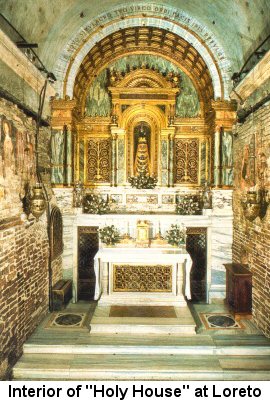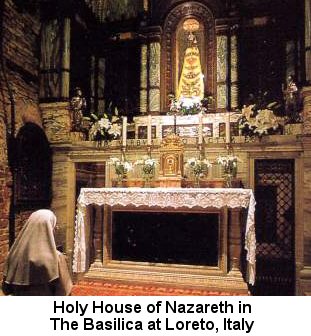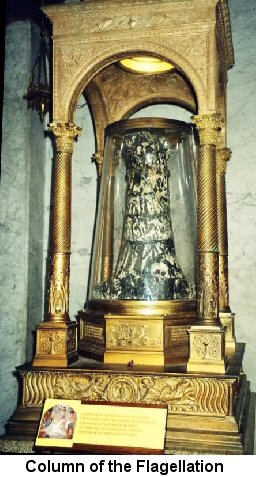Chapter
Eight
The Relics of "Lucifer Sun
Worship"
THE GROSS SUPERSTITION that
has accompanied the use of relics reveals the deception and
inconsistency with which Romanism has been plagued for
centuries. Among the most highly venerated relics have been
pieces of the "true cross." So many of these were scattered
throughout Europe and other parts of the world that Calvin once
said that if all pieces were gathered together, they would form a
good ship-load; yet the cross of Christ was carried by one
individual! Are we to believe that these pieces miraculously
multiplied as when Jesus blessed the loaves and fishes? Such was
apparently the belief of St.Paulinus who spoke of "The
redintegration of the Cross, that it never grew smaller in size,
no matter how many pieces were detached from it"!
Calvin
mentioned numerous inconsistencies regarding the use of relics,
such as: several churches claimed to have the crown of thorns;
others the water pots used by Jesus in the miracle at Cana.
Some of the wine was to be found at Orleans. Concerning a
piece of broiled fish Peter offered Jesus, Calvin said, "It must
have been wondrously well salted, if it has kept for such a long
series of ages." The crib of Jesus was exhibited for
veneration every Christmas eve at St. Mary Major's in Rome.
Several churches claimed to have the baby clothes of Jesus.
The church of St. James in Rome displayed the altar on which Jesus
was placed when he was presented in the temple. Even the
foreskin (from his circumcision) was shown by the monks of
Charroux, who, as a proof of it genuineness, declared that it
yielded drops of blood. Churches at Coulombs, France, St.
John's in Rome, and the Church of Puy in Velay also claimed to
have the foreskin in their possession!

Other
relics include Joseph's carpenter tools, bones of the donkey on
which Jesus rode into Jerusalem, the cup used at the Last Supper,
the empty purse of Judas, Pilate's basin, the coat of purple
thrown over Jesus by the mocking soldiers, the sponge lifted to
him on the cross, nails from the cross, specimens of the hair of
the Virgin Mary (some brown, some blond, some red, and some
black), her skirts, wedding ring, slippers, veil, and even a
bottle of the milk on which Jesus had been suckled.
According
to Catholic belief, Mary's body was taken to heaven. But several
different churches in Europe did claim to have the body of Mary's
mother, even though we know nothing about her and she was not even
given the name "St Ann" until a few centuries ago! Even more
difficult is the story about Mary's house. Catholics believe that
the house in which Mary lived at Nazareth is now in the little
town of Loreto, Italy, having been transported there by angels!
The Catholic Encyclopedia says:
"Since the
fifteenth century, and possibly even earlier, the
'Holy House' of Loreto has
been numbered among the most famous shrines of Italy ... The
interior measures only thirty-one feet by thirteen. An altar
stands at one end beneath a statue, blackened with age, of the
Virgin Mother and her Divine Infant ... venerable throughout the
world on account of the Divine mysteries accomplished in it ...It
is here that most holy Mary, Mother of God, was born; here that
she was saluted by the Angel; here that the eternal Word was made
Flesh. Angels conveyed Interior of
'Holy House' at Loreto this
House from Palestine to the town Tersato in Illyria in the year of
salvation 1291 in the pontificate of Nicholas IV. Three
years later, in the beginning of the pontificate of Boniface VIII,
it was carried again by the ministry of angels and placed in a
wood ... where having changed its station thrice in the course of
a year, at length, by the will of God it

took up its
permanent position on this spot ... That the traditions thus
boldly proclaimed to the world have been fully sanctioned by the
Holy See cannot for a moment remain in doubt. More than
forty-seven Popes have in
various ways r
endered honor to
the shrine, and an immense number of Bulls and Briefs
proclaim without qualification the identity of the Santa Casa di
Loreto with the Holy House of Nazareth"!
The
veneration of dead bodies of martyrs was ordered by the Council of
Trent, the Council which also condemned those who did not believe
in relics: "The holy bodies of holy martyrs ... are to be
venerated by the faithful, for through these bodies many benefits
are bestowed by God on men, so that they who affirm that
veneration and honor are not due to the relics of the saints
...are wholly to be condemned, as the Church has already long
since condemned, and also now condemns them." Because it was
believed that "many benefits" could come through the bones of dead
men, the sale of bodies
and bones became big business!
In about
750, long lines of wagons constantly came to Rome bringing immense
quantities of skulls and skeletons which were sorted, labeled, and
sold by the popes. Graves were plundered by night and tombs in
churches were watched by armed men! "Rome", says
Gregorovius, "was like a mouldering cemetery in which hyenas
howled and fought as they dug greedily after corpses."
There is in the
Church of St. Prassede a marble slab which states that in 817,
Pope Paschal had the bodies of 2,300 martyrs transferred
from cemeteries to this church. When Pope Boniface IV
converted the Pantheon into a Christian church in about 609,
"twenty-eight cartloads of sacred bones were said to have been
removed from the Catacombs and placed in a prophyry basin beneath
the high altar."
Placing
bones beneath a church or other relics were required to
"consecrate" the ground and building. The Castle Church at
Wittenberg, to the door of which Luther nailed his famous
"Ninety-five Theses", had 19,000 saintly relies!" Bishops were
forbidden by the second Nicaean Council in 787 to dedicate a
building if no relics were present; the penalty for so doing was
excommunication! Were these ideas taken from the Bible or
from sun worship ?
In the
old legends, when Nimrod the false "savior" of Babylon died, his
body was torn limb from limb - part being buried one place, and
part another. When he was "resurrected", becoming the sun-god, it was
taught that he was now in a different body, the members of the old
body being left behind. This is in contrast to the death of
the true savior, Jesus Christ, of whom it was prophesied, "A bone
of him shall not be broken" (John 19:36) and who was resurrected
in the true sense of the word. The resurrection of Christ
resulted in an empty tomb, no parts of his body being left behind
for relics!
In the
old mystery religion, the various places where it was believed a
bone of their god was buried were considered sacred -
"consecrated" by a bone. "Egypt was covered with sepulchres
of its martyred god; and many a leg and arm and skull, all vouched
to be genuine, were exhibited in the rival burying places for the
adoration of the Egyptian faithful."
The
influence of Egypt on the children of Israel is evidenced in their
setting up of the golden calf. Since Egypt was a place of
multiplied relics, the wisdom of God in the secret burial of Moses
is apparent (Deut.34:6). Since no one knew the place of his burial
and no sacred pilgrimages could be made to his tomb. Years later,
the brass serpent that Moses made was named "Nehustan" and was
worshiped as a sacred relic by the Israelites (2 Kings
18:4). If such idolatry was practiced with something Moses
made, how much deeper in idolatry would they have gone had they
possessed one of his bones!

It is
evident that the use of relics is very ancient and did not
originate with Christianity. The Catholic Encyclopedia
rightly says that the use "of some object, notably part of the
body or clothes, remaining as a memorial of a departed saint" was
in existence "before the propagation of Christianity" and "the
veneration of relics, in fact, is to some extent a primitive
instinct associated with many other religious systems besides that
of Christianity." If Christ and the apostles did not use relics,
but the use of such was known prior to Christianity and among
other religions, do we not have another example of a sun worship idea being
"Christianized"?
We do not see
that relics have any part in true worship, for "God is a Spirit: and they that
worship him must worship him in
spirit and in truth" (John 4:24). The extremism to which
the use of relics has led, is certainly not "truth." Some of the bones
that were at one time acclaimed as the bones of saints have been
exposed as the bones of animals! In Spain, a cathedral once
displayed what was said to be part of a wing of the angel Gabriel
when he visited Mary. Upon investigation, however, it was
found to be a magnificent ostrich feather!
It is not
necessary to labor long on this point. The Catholic
Encyclopedia itself recognizes that many relics are
doubtful. "Many of the more ancient relics duly exhibited
for veneration in the great sanctuaries of Christendom or even at
Rome itself must now be pronounced to be either certainly spurious
or open to grave suspicion ... difficulties might be urged against
the supposed 'column of
the flagellation' venerated at Rome in the Church of
Santa Prassede and against many other famous relics"!
The important relic of the holy
Column of Flagellation was transported from Jerusalem to
Rome by John Cardinal Colonna, one of the leaders of the sixth
Crusade, in the year of 1223, and was put up in his title
church of St. Praxedis (Italian: Santa Prassede), in the oratory
of St. Zenon. It is of jasper marble with white, black and green
specks.
How,
then, is this discrepancy explained? The Catholic
Encyclopedia continues: "...no dishonor is done to God by the
continuance of an error which has been handed down in perfect good
faith for many centuries ... Hence there is justification for the
practice of the Holy See in allowing the cult of
certain doubtful ancient relics to
continue." But, again, we would point out that true
worship is in
spirit and in
truth - not by the continuance of an error. Even if
we did have one of Mary's hairs, or a bone of the apostle Paul, or
the robe of Jesus, would God be pleased with these things
being set up as objects of
worship? According to the example of the brass serpent of
Moses, he would not. We can only ask: if there would be no
real virtue in the actual hair, bone, or robe,
how much less merit can there be in
relics which are known to be fakes?
“Signs and symbols rule the Sun Worship world, not
words nor laws.”
www.granddesignexposed.com
 took up its
permanent position on this spot ... That the traditions thus
boldly proclaimed to the world have been fully sanctioned by the
Holy See cannot for a moment remain in doubt. More than forty-seven Popes have in
various ways rendered honor to
the shrine, and an immense number of Bulls and Briefs
proclaim without qualification the identity of the Santa Casa di
Loreto with the Holy House of Nazareth"!
took up its
permanent position on this spot ... That the traditions thus
boldly proclaimed to the world have been fully sanctioned by the
Holy See cannot for a moment remain in doubt. More than forty-seven Popes have in
various ways rendered honor to
the shrine, and an immense number of Bulls and Briefs
proclaim without qualification the identity of the Santa Casa di
Loreto with the Holy House of Nazareth"! 
